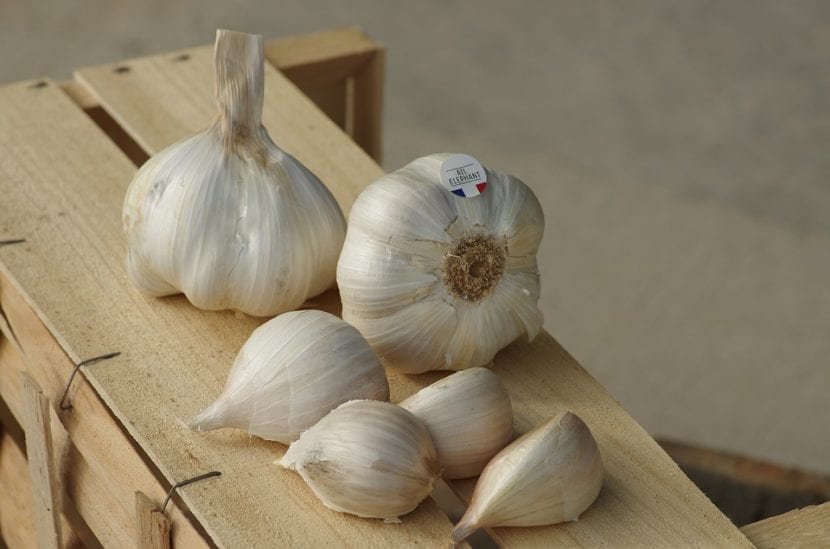

Have you heard of elephant garlic? It is a plant that develops quite large bulbs; in fact, they are almost three times the size of ordinary garlic. Of course, our protagonist is not a real garlic, but do not worry: its maintenance is also very simple.
Of course, if you plan to grow it in a pot, you will have to choose one that is wider and taller the better. Next we will tell you everything about this curious food.
Origin and characteristics of elephant garlic


Image – Wikimedia Commons / Lin content
It is a bulbous perennial native to Central Asia whose scientific name is Allium ampeloprasum var. ampeloprasum. It is popularly known as chilote garlic, oriental garlic, soft garlic, elephant garlic or large head garlic, and develops bulbs up to 10 centimeters which is made up of several fairly large teeth.
It can reach a height of about 70-100 centimeters. The leaves are long, lance-shaped, bluish-green, and flat. Its flowers are grouped in rounded inflorescences, and are very small, white in color.
What are the care it requires?
If you dare to cultivate it, we recommend taking the following into account:
Location
Chilote garlic, like most species of the genus Allium, needs to be in an area where the sun shines directlyideally throughout the day.
Distance between floors


Image – Flickr / Forest and Kim Starr
It does not take up much space, but so that it can develop normally and reach the adult size expected of it, it is important that if it is grown in the garden it is planted at a distance of about 30 centimeters of other specimens.
Earth
- Orchard: the land must be fertile and well drained, as waterlogging is very damaging.
- Flower pot: it is advisable to fill with substrate for urban garden (for sale here!), but you can use universal substrate for plants, mulch, compost, … or any other that is rich in organic matter. The only thing you should keep in mind is that it must be able to filter the water quickly, so if necessary do not hesitate to mix it with perlite, claystone or similar.
Irrigation
Moderate. You have to water every time the soil is dry, avoiding wetting the leaves.
It is highly advisable to install a drip irrigation system; in this way, the water will be able to come out with the appropriate force and during the time that is considered opportune, without risking the plant rotting.
Subscriber
Throughout the season. We recommend fertilizing with organic products, such as guano, which is very rich in nutrients and has a rapid efficiency, the compost that you can make yourself in your garden, or manure from herbivorous animals that you will find for sale in nurseries or that you can even they can sell directly on a farm.


Related article:
What types of manure are there and what are their characteristics?
Important note: if you find fresh manure, leave it in the sun for about 10 days to dry, otherwise the roots could burn, especially if the manure is from birds.
Multiplication


Elephant garlic multiplies by seeds -rarely, as it is difficult for them to become viable- and by bulbs in autumn preferably following this step by step:
Seeds
- First, fill a seedling tray with seedbed substrate (for sale here!).
- Then water conscientiously.
- Then, place a maximum of two seeds in each socket and cover them with a thin layer of substrate.
- Then water again, this time with a sprayer to moisten the top layer of the soil.
- Finally, insert the seedling into a tray without holes and place everything outside, in semi-shade.
Every time you have to water, fill the tray without holes with water. Thus the seeds, if viable, will germinate in about 7 days.
Bulbs
The easiest, safest, and fastest way to get new copies is separating the bulbs and planting them in individual pots with substrate for urban garden for example or in other areas of the garden, in full sun.
Pests
It is vulnerable to trips, but they can be treated well with diatomaceous earth or potassium soap.
Diseases
It can be affected by fungi such as mildew, roya, botrytis or the would alternate. To avoid this, you have to control the irrigation a lot, and use lands that have good drainage.
In case of symptoms (whitish, reddish, brown or orange spots, white or grayish powder, rot …) treat with a copper-based fungicide.
Harvest


Image – Wikimedia Commons / Lin content
Elephant garlic harvested more or less 200-240 days after planting. To get them to be somewhat larger, what is done is to remove the floral rods as soon as they come out.
Rusticity
Resists cold and frost up to -7ºCbut after harvesting the bulbs can be removed from the ground or substrate and stored at home in a dry place protected from direct light.
What culinary uses is given to elephant garlic?
The taste of elephant garlic is milder than ordinary garlic, and it is said to be more palatable. It can be eaten raw or cookedin the same dishes as any other Allium: meats, salads, soups …
What do you think?
